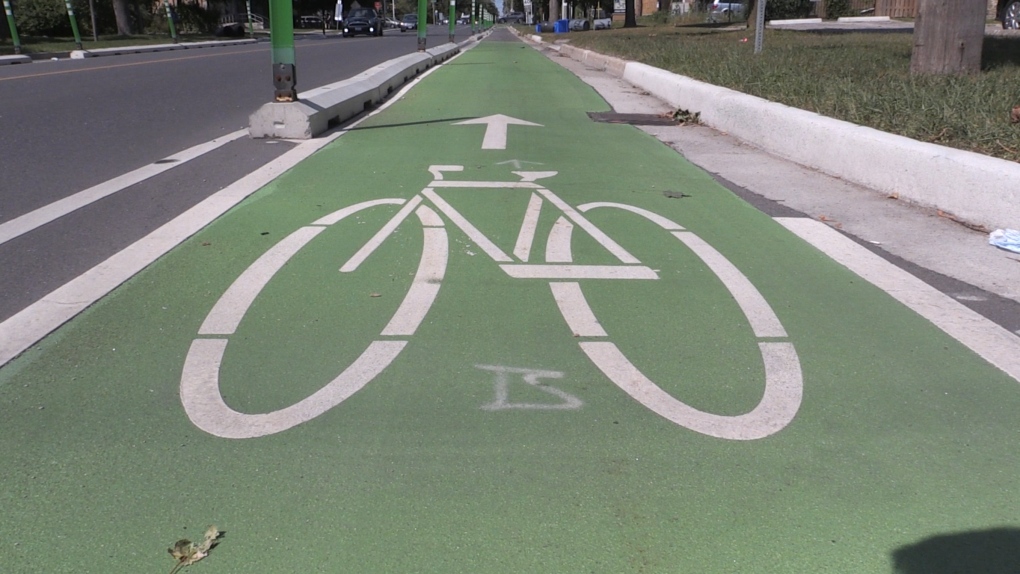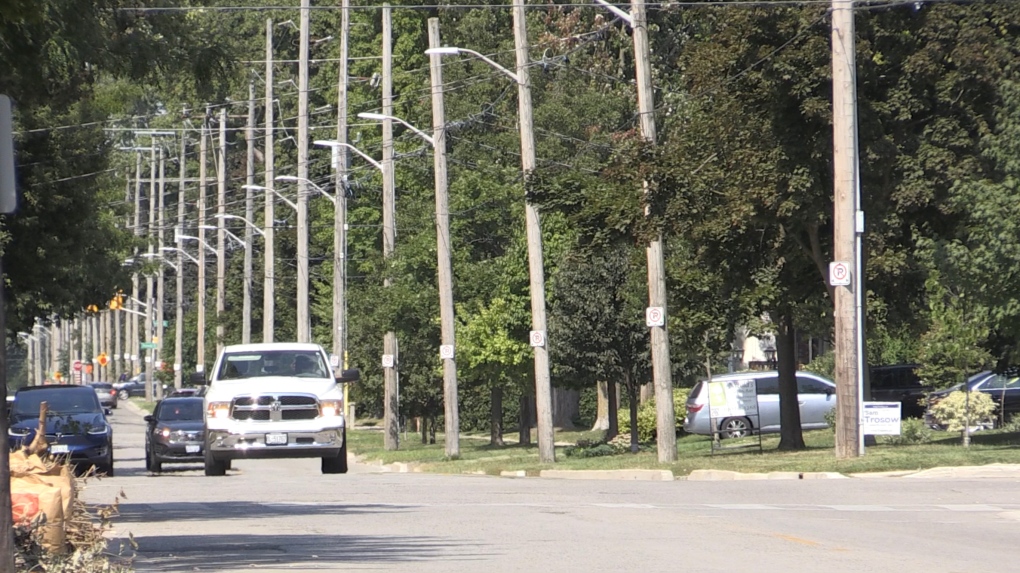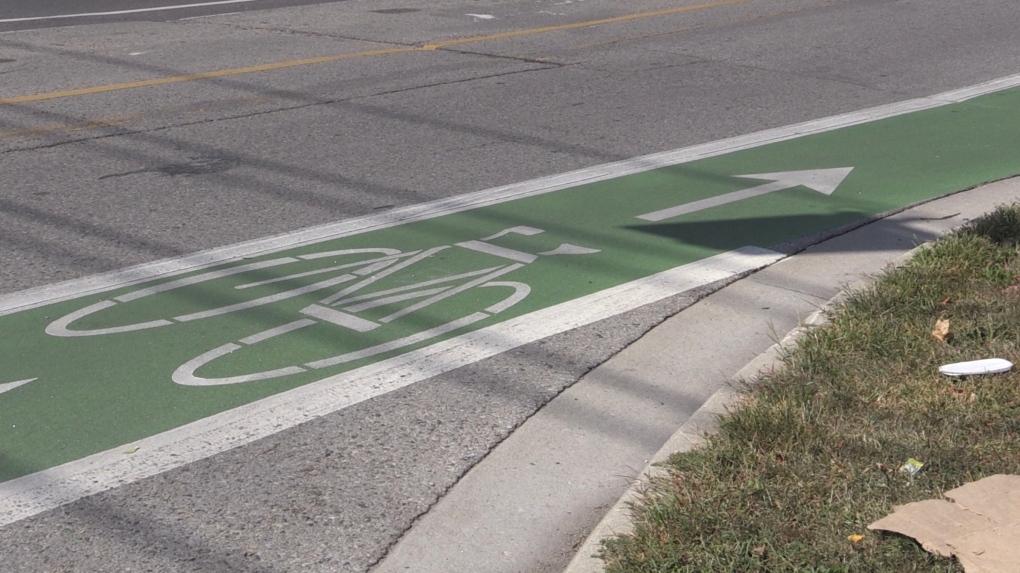'Paint is not protection': Cyclists slam plan to extend popular bike route
The city’s plan to extend a popular cycling route is facing pushback from cyclists who warn the design is not safe.
However, city hall maintains the bike lane adheres to provincial guidance and will be sufficient for the neighbourhood.
Currently, the Colborne Street Cycle Track provides a safe riding lane separated from traffic with cement curbs.
The bike lane runs between Horton Street and Oxford Street.
 The Colborne Street Cycle Track in London, Ont. on Friday, Sept. 9, 2022 (Daryl Newcombe/CTV News London)“The cars aren’t nearly as close to you, and the cars can’t jump over the curb,” explains cyclist Fern Laurence who was out for a ride.
The Colborne Street Cycle Track in London, Ont. on Friday, Sept. 9, 2022 (Daryl Newcombe/CTV News London)“The cars aren’t nearly as close to you, and the cars can’t jump over the curb,” explains cyclist Fern Laurence who was out for a ride.
Andrea Loewen, whose family bikes Colborne through the Old North neighbourhood every day, is baffled why the plan to extend the bike lane north of Oxford is for a painted lane— but no protective cement curb.
“I don’t feel safe at all,” Loewen says about riding in painted bike lanes. “There are cars zooming past me and my children. Paint is not protection, paint is not infrastructure.”
The city explains that the stretch of Colborne through Old North has significantly lower traffic volumes and has more of a “residential context” than south of Oxford.
“If the road width allowed us to add protection, we would certainly consider it,” says manager of active transportation Daniel Hall. “The challenge here is it requires more space than the existing road allows.”
The road would need to be widened by about one metre to accommodate a curb alongside the northbound and southbound bike lanes.
Hall points to the location of many hydro poles and boulevard trees to explain why widening the road would be complex and costly.
 Position of hydro polls and trees along Colborne Street north of Oxford Street in London, Ont. on Friday, Sept. 9, 2022 (Daryl Newcombe/CTV News London)He agrees that protected bike lanes are “the gold standard” but the extra cost when not warranted would require budgeted dollars earmarked for other cycling improvements.
Position of hydro polls and trees along Colborne Street north of Oxford Street in London, Ont. on Friday, Sept. 9, 2022 (Daryl Newcombe/CTV News London)He agrees that protected bike lanes are “the gold standard” but the extra cost when not warranted would require budgeted dollars earmarked for other cycling improvements.
“If it was our standard, protected (lanes) or nothing else, then it would really reduce our ability to fill in gaps that we currently have in our cycling network,” Hall adds.
But Loewen wants the city to think outside the box— like potentially converting to a one-way street.
“What’s something that we haven’t thought of? What if we made Waterloo (a) one-way street and Colborne the other way, could we then have enough space?”
 Painted bike lane in London, Ont. on Friday, Sept. 9, 2022. (Daryl Newcombe/CTV News London)
Painted bike lane in London, Ont. on Friday, Sept. 9, 2022. (Daryl Newcombe/CTV News London)
CTVNews.ca Top Stories

BREAKING Iran fires air defence batteries in provinces as explosions heard near Isfahan
Iran fired air defence batteries early Friday morning as explosions could be heard near a major air base near Isfahan, raising fears of a possible Israeli strike following Tehran's unprecedented drone-and-missile assault on the country.
American millionaire Jonathan Lehrer denied bail after being charged with killing Canadian couple
American millionaire Jonathan Lehrer, one of two men charged in the killings of a Canadian couple in Dominica, has been denied bail.
Nearly half of China's major cities are sinking, researchers say
Nearly half of China's major cities are suffering 'moderate to severe' levels of subsidence, putting millions at risk of flooding especially as sea levels rise.
Prince Harry formally confirms he is now a U.S. resident
Prince Harry, the son of King Charles III and fifth in line to the British throne, has formally confirmed he is now a U.S. resident.
Judge says 'no evidence fully supports' murder case against Umar Zameer as jury starts deliberations
The judge presiding over the trial of a man accused of fatally running over a Toronto police officer is telling jurors the possible verdicts they may reach based on the evidence in the case.
Health Canada to change sperm donor screening rules for men who have sex with men
Health Canada will change its longstanding policy restricting gay and bisexual men from donating to sperm banks in Canada, CTV News has learned. The federal health agency has adopted a revised directive removing the ban on gay, bisexual and other men who have sex with men, effective May 8.
Colin Jost names one celebrity who is great at hosting 'Saturday Night Live'
Colin Jost, who co-anchors Saturday Night Live's 'Weekend Update,' revealed who he thinks is one of the best hosts on the show.
Sports columnist apologizes for 'oafish' comments directed at Caitlin Clark. The controversy isn't over
A male columnist has apologized for a cringeworthy moment during former University of Iowa superstar and college basketball's highest scorer Caitlin Clark's first news conference as an Indiana Fever player.
'Shopaholic' author Sophie Kinsella reveals brain cancer diagnosis
Sophie Kinsella, the best-selling author behind the 'Shopaholic' book series, has revealed that she is receiving treatment for brain cancer.
































